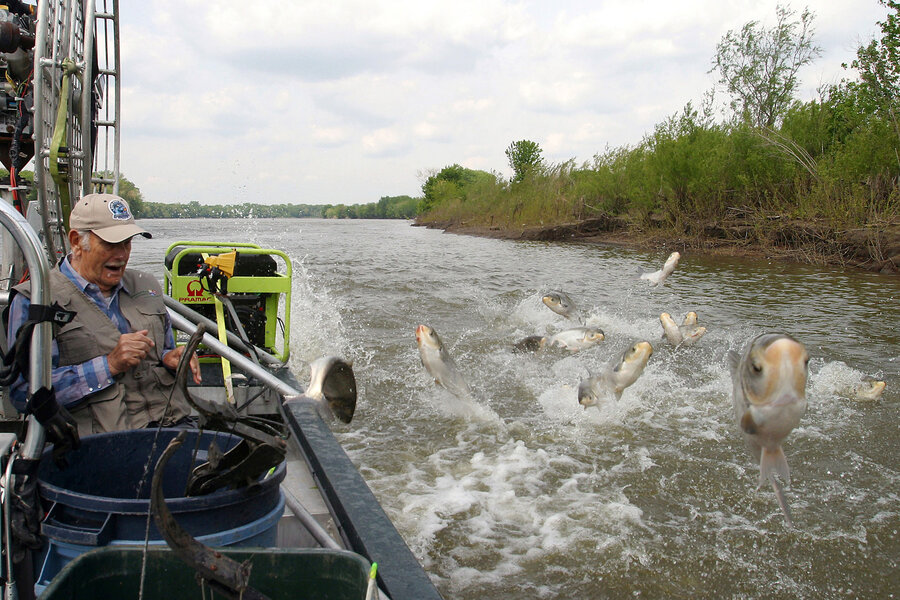Goldfish or Asian carp? Why it matters in the Great Lakes.
Loading...
A carp, by any other name, could still be dinner.
A bill passed Tuesday in the House of Representatives gives the Great Lakes Restoration Initiative $300 million annually. Although a huge chunk of this budget is slated to preserve the Midwestern waterway by keeping invasive Asian carp out, many who study and fish the Great Lakes are recognizing that the impacts of invasive species, both environmental and economic, sometimes call for creative approaches to mitigation.
"What we’ve seen with invasive species is kind of the front end of the process," says Richard King, a conservation biologist at Northern Illinois University. "What we haven’t seen is what happens over the longer term. Do invasive and native species eventually come into some kind of coexistence?"
Dr. King points to the invasive round goby fish, whose rapid proliferation created a new food source for the Lake Erie Water Snake. The snake was listed as threatened under the Endangered Species Act in 1999 but has since been delisted, partly because it shifted its diet to eat the invasive fish.
Another invasive fish is proving to have some uses for Great Lakes fishermen. Non-native goldfish – also known as golden carp – have been arriving at docks as a byproduct of more traditional catches for at least 50 years, and states have tried to persuade pet owners to keep unwanted goldfish out of waterways, with mixed success.
In the past two decades, commercial fishermen have chosen to make lemonade from their lemons, or rather, found a way to turn a profit from the non-native goldfish, Garret Ellison reported for Michigan Live. The goldfish Michigan's fishermen once threw away yielded $68,369 in revenue in 2015.
"We've been catching 'em forever," Dave DeLong, a Lake Erie commercial fisherman, told Michigan Live. "Now, we're selling 'em. It's just another species we can make a few dollars off."
So far, only Lake Erie produces a significant enough goldfish catch to market profitably, but the non-native species "flirts with breaking into the top 5 most lucrative species in Lake Erie every year, from a Michigan standpoint," Tom Goniea, fisheries biologist with the Michigan Department of Natural Resources, told Michigan Live.
Scientists say that the goldfish do not harm the rest of the ecosystem and offers an example of the ambivalent role non-native species can play.
"I think most purists and biologists would prefer not to have them as part of the wild environment, but I'm not sure they meet the classification of harmful," Mr. Goniea said.
Not all invasive species are so benign. Wildlife officials have worked for years to keep the invasive Asian carp from entering the Great Lakes via the Mississippi River, as an Asian carp population would expand so quickly it could devastate the $7-billion Great Lakes fishing industry.
"It's very sobering," Marc Gaden, spokesman for the Great Lakes Fishery Commission told the Associated Press. "Lake Erie is one of the most productive inland fisheries in the world. It wouldn't be as valuable by any stretch of the imagination if one out of every three pounds of fish were Asian carp."
In places where an invasive species is established, however, some creative entrepreneurs still find ways to work with them. The founder Angie Wu of Two Rivers Fisheries told The Wall Street Journal her inspiration came after she read an article calling the proliferation of Asian carp a "disaster." Knowing most Chinese consider the fish delicious, she effectively markets the catch as a scrumptious "Kentucky white fish" in China.
The company is now catching as many as 15,000 Asian carp daily and shipping them to carp-loving Asians. The company nearly doubled its shipments after opening in 2013 and cannot keep up with demand.
"There's just not enough fishermen to take care of what I need," says Jeff Smith, the company's operations manager. "I want 20,000 to 25,000 a day."
The opportunism of water snakes, fishermen, and Asian carp marketers demonstrates that not all the impacts of invasive species are equal, and not all are negative.
"I think it’s naïve to say, 'Oh we’re going to get rid of invasive species in the Great Lakes," King says. "The water snake-goby example is a good example of how the impacts might be unexpected."








